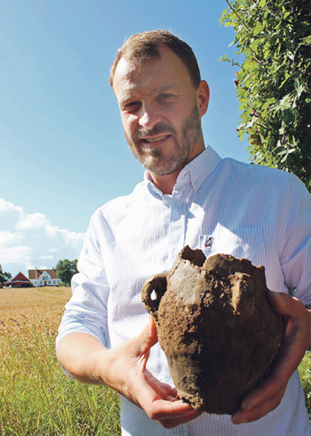
About Ceramic Studies
Analyses and studies of pottery and other material of burned clay from archaeological excavations. Please contact me for further information!
Thin section analyses, thermal analyses and ICP-analyses. The main task is to create a picture of the prehistoric and the historic society. Ceramic Studies is involved in different projects in Northern Europe, The Netherlands and in Germany
Analyses made by Ceramic Studies
Ware analyses � thin section analyses
A ware analyses gives answers which type of raw material that have been used to the pot or in the clay. It is a method that is performed under a polarising microscope, and the microscopy is made out of a thin section. The microscopy is made at magnifications between 25 x and 1000 x, in parallel as well as in polarised light. Under a polarising microscope it is possible to identify minerals in the silt and sand fractions of the sherds. But microscopy offers not only a petrographic study; it also shows other aspects of the pottery craft. It is possible to study different ware structures, such as vessel forming technique, clay type, difference between added and natural temper, as well as amount and grain size of the temper, organic matter e.g. diatoms and plant material, etc.
Chemical analysis by ICP-AES
A chemical analysis decides the sherds chemical identity, and the method that is used is an ICP (Inductively Coupled Plasma) analysis. The chemical analyses can be used to point out the geographical origin of the pottery. It can also be used to identify metal remains in objects such as crucibles and mould. The selected sample (minimum 1 g) is grinded to a fine powder and solved in a 4-acid solution. These solutions are injected into excited argon plasma. When atoms are exposed to energy the electrons change and rechange orbits, causing a coloured light (emission spectra) that can be measured by AES – Atomic Emission Spectrometry. 45 minerals and trace elements are measured, and the frequency is used to identify different groups. These chemical groups are then compared with samples in a database, which contains material from different parts of Europe. The correlation between different samples is finally determined by a principal component analysis.
Thermal analyses
Thermal analyses: A thermal colour is a method to estimate the firing temperature, based on colour changes of the clay during repeated firing. The firing is carried out at intervals of 100ºC until a temperature of 1350ºC is reached. The sample of either potsherds or burned clay is fired 15 minutes at every interval. The colour is coded according to hue, value and chroma (according to Munsell Soil Color Charts). Each of these data is recorded separately on a graph. It is essential for the success of the test that the colour of the clay only starts changing when the original firing temperature is exceeded. This way, the original firing temperature can be estimated within a 100ºC interval.